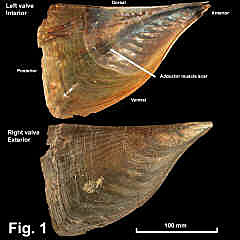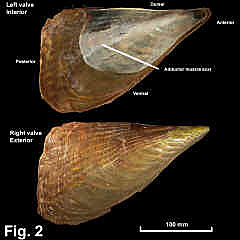|
|
PINNIDAE |
|
|
|
Atrina strangei (Reeve, 1858) Description: Shell moderately fragile, translucent. Shape broadly triangular, sharply pointed anteriorly, squared off posteriorly; dorsal margin straight or slightly concave, ventral margin concave at anterior end, then smoothly convex. Shell gaping at dorsal end and at byssal area at anterior-ventral margin. Hinge along anterior half of dorsal margin. Interior with nacreous area extending 2/3 of shell length, not divided by longitudinal groove. Adductor muscle scar within nacreous area, poorly defined. Exterior with 13-16 strong, widely spaced radial ribs on dorsal side, spines absent. Shell colour mid to dark brown. Size: Largest specimen seen 250 mm in length. Distribution: Eastern Australia and Solomon Islands. Australian Museum specimens available are: 35 fathoms (64 m) off Tin Can Bay, Qld (Fig. 1); 55 m off Tweed Heads, NSW; 46-55 m off Norah Head, NSW (Figured by Hedley, 1924, Pl. 20, Fig. 10). Schultz & Huber (2013) include the Solomon Islands in the distribution, but there are no specimens in the Australian Museum collection to confirm this range extension. Habitat: Subtidal. Comparison: This species has been misidentified as Atrina pectinata (Linnaeus, 1767), a species which is found in the northern Indian Ocean, not in Australia. Atrina assimilis (Reeve, 1858) is somewhat similar but is narrower and densely spined; it occurs in northern Australia. Atrina serra (Reeve, 1858), supposedly occurs in NSW according to Schultz & Huber (2013), but it differs from A. strangei by having numerous spined ribs. Synonymy: None. Remarks: Two additional specimens in the Australian Museum collection (one shown in Fig. 2) are the same as this species in sculpture and colour but more elongate. Whether they are the same species or not is unclear. Fig. 1: 35 fathoms off Tin Can Bay, Queensland (C.119296) Fig. 2: Port Jackson, Sydney Harbour, NSW (C.11538)
|
|

